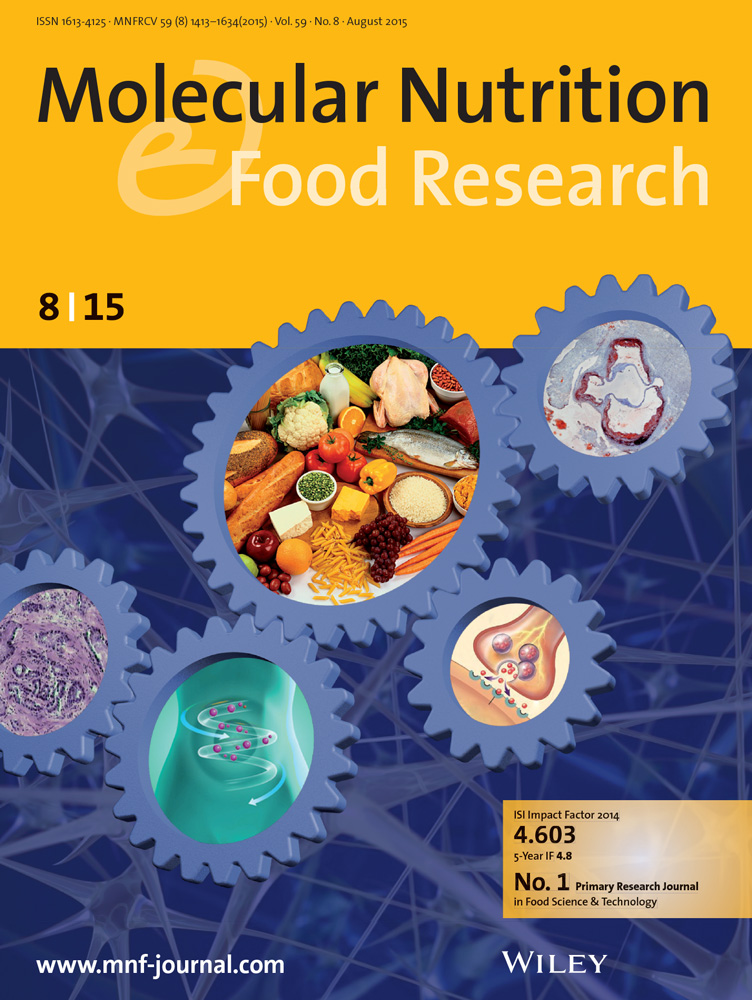Effect of Nutraceutical Supplementation and Mediterranean Hypocaloric Diet on Calculated Steatosis Indices and Inflammation: Clinical and In Vitro Evidences
IF 4.2
2区 农林科学
Q1 FOOD SCIENCE & TECHNOLOGY
引用次数: 0
Abstract
This study evaluated the effect of a nutraceutical supplementation (NS) and Mediterranean hypocaloric diet (MHD) on hepatic steatosis indices (HSIs), γ‐glutamyl transferase (γGT), and lipid profile in adults with hyperlipidemia and nonalcoholic fatty liver disease (NAFLD). In vitro study on HepG2 cells explored potential molecular mechanisms. A retrospective study was conducted on 45 overweight/obese subjects (19 M) prescribed MHD with/without NS. Anthropometric data, biochemical parameters, HSIs, and γGT were collected at baseline and after 3 months. In vitro, cells were pretreated with single and mixed NS components and then with tumor necrosis factor α (TNFα) or fatty acids (FAs). Antioxidant and antiinflammatory activities were evaluated by fluorescence assays and quantitative polymerase chain reaction or enzyme‐linked immunosorbent assay; antiapoptotic effects by Western blot. After 3 months, all subjects improved anthropometric and biochemical parameters but only the combined MHD and NS treatment significantly reduced insulin resistance, HSIs, low‐density lipoprotein cholesterol, and γGT. In vitro, treatment with mixed NS components decreased TNFα‐/FAs‐induced reactive oxygen species. Combined treatment also modulated the inflammatory response by lowering interleukin‐6 and interleukin‐1β, increasing interleukin‐10 and pro‐caspase 8 expression. These findings suggest that NS, due to its antiinflammatory properties, represents a promising strategy for NAFLD management.营养保健品补充和地中海低热量饮食对计算脂肪变性指数和炎症的影响:临床和体外证据
本研究评估了营养补充剂(NS)和地中海低热量饮食(MHD)对高脂血症和非酒精性脂肪性肝病(NAFLD)成人肝脂肪变性指数(HSIs)、γ‐谷氨酰转移酶(γ gt)和脂质谱的影响。HepG2细胞的体外研究探讨了可能的分子机制。回顾性研究了45名超重/肥胖受试者(19名)服用MHD伴/不伴NS。在基线和3个月后收集人体测量数据、生化参数、hsi和γ - gt。体外分别用单一和混合NS成分预处理细胞,再用肿瘤坏死因子α (TNFα)或脂肪酸(FAs)预处理细胞。采用荧光法和定量聚合酶链反应或酶联免疫吸附法评价抗氧化和抗炎活性;Western blot检测抗凋亡作用。3个月后,所有受试者的人体测量和生化参数均有所改善,但只有MHD和NS联合治疗显著降低了胰岛素抵抗、hsi、低密度脂蛋白胆固醇和γ - gt。在体外,混合NS组分处理可减少TNFα‐/FAs‐诱导的活性氧。联合治疗还通过降低白细胞介素- 6和白细胞介素- 1β,增加白细胞介素- 10和前半胱天冬酶8的表达来调节炎症反应。这些发现表明,NS由于其抗炎特性,代表了NAFLD管理的一个有希望的策略。
本文章由计算机程序翻译,如有差异,请以英文原文为准。
求助全文
约1分钟内获得全文
求助全文
来源期刊

Molecular Nutrition & Food Research
工程技术-食品科技
CiteScore
8.70
自引率
1.90%
发文量
250
审稿时长
1.7 months
期刊介绍:
Molecular Nutrition & Food Research is a primary research journal devoted to health, safety and all aspects of molecular nutrition such as nutritional biochemistry, nutrigenomics and metabolomics aiming to link the information arising from related disciplines:
Bioactivity: Nutritional and medical effects of food constituents including bioavailability and kinetics.
Immunology: Understanding the interactions of food and the immune system.
Microbiology: Food spoilage, food pathogens, chemical and physical approaches of fermented foods and novel microbial processes.
Chemistry: Isolation and analysis of bioactive food ingredients while considering environmental aspects.
 求助内容:
求助内容: 应助结果提醒方式:
应助结果提醒方式:


